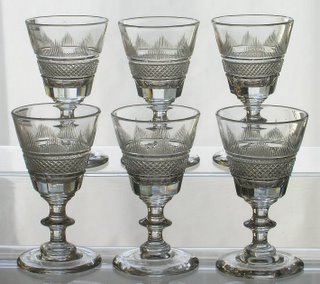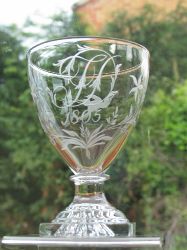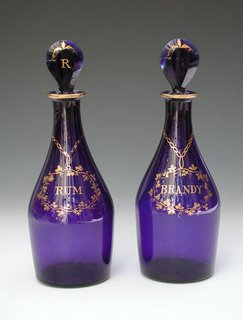
 An Englishman liked his drink. Gin, rum, and brandy was the ordinary fare, found in pubs and taverns across England. One could not trust the water, after all, and water did not rouse the spirits half so well.
An Englishman liked his drink. Gin, rum, and brandy was the ordinary fare, found in pubs and taverns across England. One could not trust the water, after all, and water did not rouse the spirits half so well.
Gentlemen had to be more particular in their choice of drink–good wines and spirits did for him–although I imagine the effect was the same.
I thought it would be interesting to see some examples of the serveware that would have been used. Above is an example of six sherry or port glasses circa 1810 and at the left is a wine glass circa 1750–that is, if it is not an ale flute–I’m not quite sure of that, but it looks like a wine glass to me.

Following first is a decanter circa 1820. The quality seems quite fine; I expected to find more irregularities in the glass when I began this search, but it seems that there is quite a variety, I
suppose depending on the maker and the market the piece was intended for.
Next is a very nice etched wine glass circa 1770 with a very inter-esting swirled stem. You may notice that the bowl is not very big; in formal dinners where there might be numerous toasts, one could not get “potted” after the first two.
circa 1770 with a very inter-esting swirled stem. You may notice that the bowl is not very big; in formal dinners where there might be numerous toasts, one could not get “potted” after the first two.
Finally, there is a pair of cobalt decanters marked “rum” and “brandy” (1790)
and a “rummer”–a rum glass of which it seems many have survived, since I found quite a few examples for sale on the internet.
seems many have survived, since I found quite a few examples for sale on the internet.
Armed with this information, as little as it is, you can at least imagine what a gentleman might have thrown at his grate at the end of a rousing toast…or perhaps, in a fit of temper!
Glass enthusiasts–I am a novice in this arena and would love your input!
Laurie
LORD RYBURN’S APPRENTICE
Signet, Jan. 2006


How were they not totally drunk all the time? Especially the ladies, who drank, too? I know I feel tipsy after one glass, no matter how small. The pictures are lovely, Laurie, thanks for the information. I will remember it next time my hero needs to throw some glassware at someone.
I’m not a glass enthusiast, but these pictures are terrific! They will help me visualize as I’m reading.
I wonder about the drunkenness, too, Megan. I remember reading in a bio of Wellington that some men criticized him for not drinking enough. Apparently if a man had just a few glass of wine during dinner and a glass of port or so afterwards he was considered abstemious.
Love the beautiful glasses, though. I’m no expert, so not much to add except that I highly recommend anyone passing that way to stop at the Corning Museum of Glass (http://www.cmog.org). Their galleries of full of gorgeous glass from all periods of history.
Elena 🙂
Gorgeous pictures! Just looking at them, I had horrible visions of bumping into them and breaking them. 🙂
Maybe they WERE drunk all the time, and that was the key to duelling? 🙂 (Wow, I’m very smiley this morning). I couldn’t have handled it. It sounds a bit like a college professor I had, who taught Medieval history. He pointed out that, with the very brief life expectancy, the world was basically being run by adolescents, which made a lot of things make more sense. 🙂 (Darn! No more smileys)
I think I saw some of these on Masterpiece Theatre last night…
They really are beautiful. I’d hate to see them thrown into the fireplace after a toast!
Well, they did drink water too… But I think when one drinks regularly (and in large amounts), alcohol affects one less…so those gentlemen probably did not get drunk very easily, particularly on beer or ale.
Cara